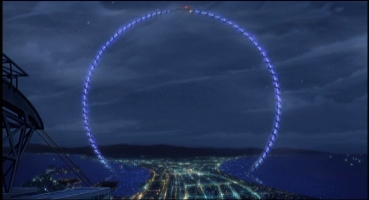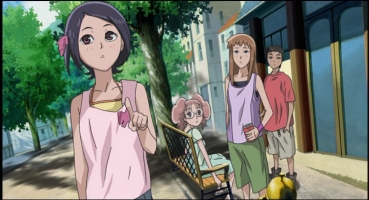|
In
my review of Serial
Experiments Lain, I remarked that the series was
what Digimon scribe Chiaki Konaka can do when he's
allowed to write more than just children's stories. Noein
– To Your Other Self almost turns this idea on its head;
it's what Digimon could've been had it been written
for a more mature audience. It shares a few plot points
with Digimon – the cast of likeable teenagers, the
concept of another dimension existing alongside our own
– but also explores other elements, going into more detail
about the lives and personalities of its main characters.
Noein is set in two realities. One is the normal Japanese city
of Hakodate, and the other is the post-apocalyptic wasteland
called La'cyrma. In Hakodate, schoolfriends Haruka, Yuu,
Ai, Isami and Miho have just begun their summer break, and
have too much time on their hands. Spurred on by rumours
of black-cloaked "ghosts" that have been sighted around
the city, they decide to go ghost-hunting late at night
– and unwittingly involve themselves in a plot by the inhabitents
of La'crymosa (including the enigmatic Karasu and psychotic
Atori, who are the "ghosts") to capture the mystical item
known as the Dragon Torque. With this item, they may be
able to prevent La'crymosa's destruction at the hands of
the merciless Noein. Their search for the Dragon Torque
leads them directly to Haruka and Yuu – these two children
may hold the key to finding the all-important item.

Also
hot on the trail of the paranormal are two "investigators",
Uchida and her partner Kooriyama. The extent of their involvement
in the plot has yet to be revealed, but – although they're
a little slow on the uptake – they're starting to realise
the connection between Haruka and the "ghosts" of La'cryma.
What
makes Noein stand apart from other series involving
groups of children and parallel worlds is its willingness
to delve deeply into the lives of each of the children.
Half of the episodes' runtime is dedicated to exploring
the relationships between the characters: Haruka and Yuu
are plainly very much in love, but Yuu's domineering mother
stands in their way; Ai and Isami are engaged in a playful
love-hate relationship that neither will admit; Miho is
very excitable and loud, but often provides deep insights
into the situation that turn out to be correct. All of these
characters are believable in context, too – they don't openly
accept the supernatural situation they find themselves in.
Only Haruka and Yuu seem to really believe it, as they're
the ones targeted by the "ghosts", while the others are
content to dismiss them as mere shadows and hallucinations.
And Uchida and Kooriyama's "buddy-cop" scenes, while intended
as mild comic relief, shows signs of developing further
as their involvement in the series increases.
Let's
not forget Noein's crowd-pleaser scenes: battles.
While on the surface, they appear to be simple energy-flinging
fantasy affairs à la Naruto,
they're not just for show – all of the battles happen for
a reason, and are never simply included to fill space. In
their execution, they're mostly traditional animation with
some CGI effects, which works fine. And drifting over to
comment on the animation itself: I found that while CGI
is sometimes used in odd places (to render suburban buildings
or cars, etc), it complements the cel animation rather than
detracting from it. At least once every episode, a gigantic
CGI "ourobouros" shimmers into existence over the city;
this never fails to instill a sense of awe.
The
series' English dub track benefits from some of the most
recognisable English voice actors in the business – Melissa
Fahn, Crispin Freeman, Richard Epcar and Mona Marshall all
give exemplary performances. The background music is also
a standout, much more memorable than most generic animé
compositions – it employs choral chanting and some orchestrated
effects reminiscent of Joe Hisaishi's work for Hayao Miyazaki.
I wasn't too keen on either of the image songs played over
the credits – they're all starting to sound very samey these
days.

Noein is a slow-boiling series that blends characterisation and
plot continuation so that sometimes the characters drive
the plot, and other times the plot drives the characters.
It's an interesting mixture; the dark and absorbing plotlines
appealed to my sci-fi needs, while the excellent characterisation
fleshed the plot out with believable figures. Too often,
animé has been all about style and lacked substance,
the characters merely cyphers in masks used as pawns in
a grand scheme. In Noein, the plot can't move without
the characters; they form the backbone of the series. You'd
probably enjoy this series if you were enthralled by Lain,
but I have a feeling that although they're very well developed,
the mere fact that the central cast are all young teens
would put a few people off. In either case, I'm looking
forward to volume 2.
An
anamorphic 16:9 transfer that although converted from NTSC
to PAL displays a good level of colour and detail. The familiar
over-exposed look to some scenes is deliberate, and the
CG elements are well blended with the traditional cell animation.
Japanese
and English tracks are offered in Dolby Stereo 2.0, Dolby
Surround 5.1 and DTS Surround. The 5.1 mix puts the surrounds
to effective use with location atmospherics, echoes and
specific sound effects, and there is clear seperation throughout.
The DTS appears to be almost identical to the 5.1 track.
Volume
1 of Noein comes with part one of a documentary
that looks at the real-life town of Hakodate. Director Kazuki
Akane and Haruka's Japanese voice actor Haruka Kudo look
around the city – a popular tourist attraction, with its
three famous hills and cable car to a summit overlooking
the city – and take note of all the locations that were
flawlessly recreated in the series. The attention to detail
by the animators is impressive; they drew perfect representations
of Hakodate's schools, parks, suburban and city areas, and
even captured the magnificent vista from the top of the
town's highest hill.
The
usual trailers: Naruto,
GiTS 2nd Gig, Robotech,
Tactics and Karas.
|